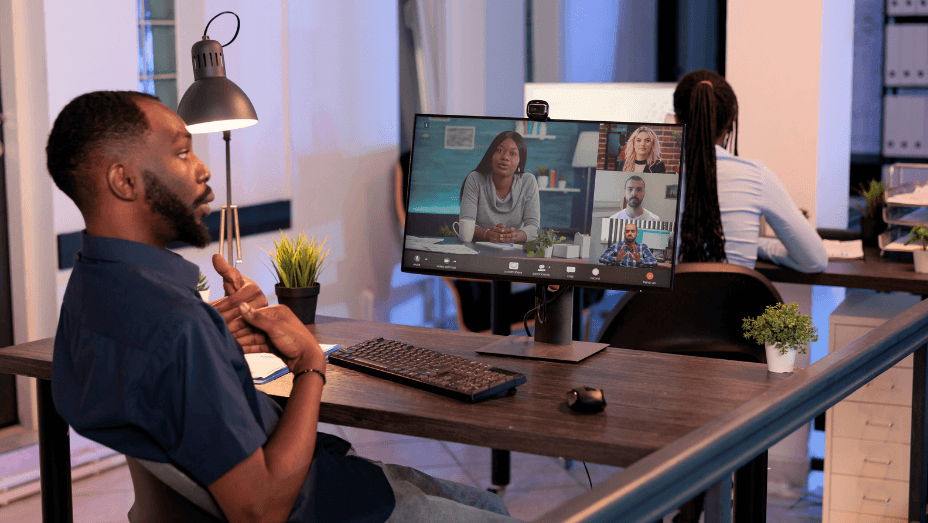Digital communication has completely transformed the modern workplace. Think back to the early days of office technology with the humble typewriter and the mechanical calculator. These tools paved the way for the innovations we see today – and there are plenty of them!
These advances not only improve the flow of information, but also ensure that important data reaches the right people at the right time. New office technology helps us do everything better, from boosting team morale to enforcing safety protocols and integrating updates.
In the newest episode of the WorkplaceWhiz podcast, Cosmin Patlageanu spoke to Natalia Vorontsova, Senior Account Manager at ProDVX Europe, about the fascinating intersection of technology and workplace dynamics, with a particular focus on digital communication revolutionizing the way we connect, collaborate and create in the workplace.
In her impressive 18-year career, Natalia has gained a wealth of experience in sales, marketing and business development in key regions such as the Middle East, Mediterranean, Scandinavia and Eastern Europe. She has successfully demonstrated the importance of integrating software and hardware for project success and was happy to share some insights.
Digital Communication and the Overall Employee Experience
First things first: employees’ workplace experience is linked to corporate culture. It's important for modern companies to offer flexible working conditions that allow employees to work in the office, remotely or on the go. This helps employees work efficiently, supports company culture and is a big reason why many companies haven't come to a standstill during COVID, but have actually flourished.
ProDVX, a major player in the hardware industry, is one of them.
Both before and during COVID, conference room signage screens were their main product – companies started to digitize extensively when employees had to work from home, and they continue to do so when employees return to the office. Many began using meeting room signage systems that allow room booking via apps and integration with scheduling tools – has this worked? Judging by their success, it did.
Accelerating Digital Transformation in the Workplace
The rapid adoption of digital transformation in the workplace, particularly in the wake of COVID-19, is a fascinating topic. However, according to Natalia, the push towards new technologies isn't entirely new. The shift from desk phones to cell phones has been a significant change – calling a standard line with an extension now often connects directly to a person's cell phone.
This seamless connectivity was unthinkable years ago, when company-provided cell phones were rare and considered a special perk. Today, it's standard to have a company phone or at least a SIM card. Similarly, before the pandemic, not every employee had a company-provided laptop – now most do. This evolution mirrors the transition of meeting room signage from a luxury to an office staple.
For years, companies had heard about and toyed with the idea of meeting room signage systems. But, over time, they transitioned from nice- to-have perks to essential office commodities. Today, meeting room signage is essential to avoid overbooked rooms and provide employees with suitable spaces for different types of meetings, such as brainstorming sessions or more emotional discussions.
At the same time, the transition from traditional offices where receptionists led the way to modern workplaces with digital displays has significantly changed office interaction. Interactive calendars and booking systems have become the norm, reflecting the general trend towards digitization. And as the saying goes: we're only getting started!

Embracing Digital Navigation and Communication
While in smaller offices you may not need an app to find your way around, larger environments such as hospitals or large corporate offices benefit significantly from digital navigation.
Instead of relying solely on a receptionist, many offices display information on screens, such as directions, which elevators to take, and where meetings are held. Some places still have receptionists, others have screens where you can order coffee with a simple press of a button – it varies around the world.
In the Middle East, for example, large screens are common for meeting room signage. These screens offer a range of options, from booking rooms to ordering catering and equipment, a convenience that stems from the fact that large office buildings have on-site catering services that make digital ordering a necessity.
In Europe, large screens are not yet widely used for such purposes. However, as screens become more multifunctional and offer more than just booking functions, their size makes them more convenient and user-friendly. And although European offices do not currently use catering services on such a large scale, this could easily change.
Technology Is Changing the Way We Interact
While technology is successfully streamlining manual processes, it’s also changing the way we interact.
You might still wave to a colleague to grab a coffee, but digital systems are increasingly taking over these requests and reducing face-to-face interaction. That's why it's important to maintain a balance between digital convenience and face-to-face interaction. Many companies are striving to preserve their authentic culture and ensure that tech strengthens interpersonal relationships rather than destroying them.
Even in highly digitized offices, employees value spending time with their colleagues in person. However, tech is enabling flexibility by allowing participation in meetings from home via smart screens. Features such as AI notes during meetings ensure that someone who has missed a session can easily catch up later – and they are only one example.
This mix of digital tools and face-to-face interaction shows how the workplace is evolving. The aim is to create an environment where technology supports efficient communication and collaboration – without losing the human touch.
The Evolution of Interactive Screens
Originally, screens had a basic informational function. However, they have since evolved into interactive tools that facilitate remote collaboration and increase productivity in the office. The transition from static information displays to interactive hubs has been gradual, yet transformative.
Natalia pointed out that interactive screens now play a central role in office collaboration. In a meeting room, for example, interactive screens allow users to extend the meeting time or check room occupancy and control room equipment such as projectors, lighting and microphones — all with a simple touch.
These functions significantly increase efficiency and flexibility in the workplace. Whether it's extending a meeting, managing room logistics or adjusting technical settings, interactive screens provide a user-friendly interface that fits seamlessly into modern office environments.
And, as technology advances, interactive screens are expected to further streamline operations and encourage collaboration, both in physical offices and in hybrid work environments where interactions increasingly take place remotely.
The evolution from static to interactive screens underlines a broader trend towards the integration of intuitive technology solutions that support employees and optimize workplace functionality.
Software Innovation Drives Hardware Evolution
Software is driving innovation in the functionality of interactive screens, leading to improvements in performance, speed, durability and ease of maintenance. As software offers more and more possibilities, hardware manufacturers need to ensure that devices are optimized to support these new applications.
In addition to traditional uses such as controlling AV equipment in meeting rooms, there are always more modern uses for interactive screens. For example, they serve as control panels for smart offices and control tasks, such as switching air conditioning systems on and off.
Collaboration between software development and hardware design will continue to determine the future of work. By aligning hardware capabilities with evolving software requirements, manufacturers can meet the demands of increasingly sophisticated customer experiences and applications.

From ID Cards to AI Integration
A major change in the evolution of office technology was the introduction of ID cards for access control. This concept, which dates back to the 1950s with punch cards, has evolved considerably. Today, smartphones have become multifunctional tools that replace traditional ID cards and can be combined with modern office technologies such as interactive tablets and screens.
And although the adoption of AI still varies from region to region due to legal regulations, its potential to increase efficiency and productivity is undeniable. Natalia envisioned a future where AI is seamlessly integrated into everyday office life and could transform the way tasks are managed and executed.
While some companies are fully embracing digital transformation, it’s true that others prefer to maintain traditional, human-centered approaches. However, Natalia observed a trend where even seemingly traditional companies are incorporating more digital elements than before to increase operational efficiency – all while still maintaining their unique identity.
Ultimately, digitization should serve practical purposes and improve convenience, efficiency and company culture. Whether through AI advancements or integrated software solutions, the goal is to use these tools to support employees and optimize workflow management.
Integrating Modern Technology into Historic Office Spaces
While some regions are known for their sleek, modern office designs, others must work within the constraints of historic architecture. Fortunately, older buildings often provide a unique backdrop for the integration of advanced technologies that can surpass modern structures in terms of creativity and functionality.
The art of blending old and new, a task that requires expertise in the use of digital tools for smart office solutions, not only increases operational efficiency but also preserves the aesthetic integrity of historic spaces.
The conversation also turned to the different needs of a multi-generational workforce and the importance of creating work environments that appeal to all employees. Organizations must ensure that technological advancements support, rather than alienate, employees, as bridging generational gaps and encouraging a valuable exchange of knowledge between colleagues of all ages is critical to fostering collaboration.
Digitalization is not about giving up authenticity or tradition, but about thoughtfully integrating modern technologies to create an inclusive, efficient and engaging work environment. This approach harnesses the potential of technology to improve workplace dynamics and productivity across generations – a win-win for all involved.
Navigating Feedback in Remote Collaboration
The problem with effectively communicating feedback via remote tools is that nuances are often lost in digital communication, especially between different cultures. For this reason, it might be wise for colleagues to meet in person at least occasionally to better understand and interpret feedback from each other.
Some companies have adopted remote working on a large scale, while others have opted for hybrid models. Natalia advocated a balanced approach where she values the flexibility of remote working while appreciating the benefits of in-office interaction, especially in areas where proximity is important.
The discussion highlighted the complexity of modern working arrangements, where the preferences and needs of individual professionals vary greatly and managers must learn to adapt their communication strategies to find a middle ground that accommodates different working styles and preferences.
Through the intelligent use of digital tools and face-to-face conversations, companies can create a productive and harmonious working environment that leverages the strengths of remote working while preserving the essential human element of collaboration.

Embracing Technology in the Workplace: Balancing Innovation and Human Interaction
Both the benefits and potential pitfalls of integrating technology into modern workplaces were discussed: from the crucial role of internet connectivity in today's digital landscape to the concerns many people have that jobs could be displaced by automation and artificial intelligence.
Natalia was optimistic. She acknowledged the efficiency gains from new technologies, but emphasized that these innovations must complement, not replace, human interaction. Advances in AI and automation should merely enable employees to streamline their tasks and free up time for interpersonal and creative activities.
Further innovations in interactive screens and AI applications will likely pave the way for more efficient and welcoming work environments around the world, but also help us preserve the essential human elements that enrich our workplace dynamics. We can’t wait to see how it all unfolds!
Want to listen to the full conversation?
You can listen to the podcast on YouTube, Spotify, or Apple Podcasts.







